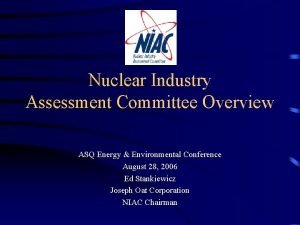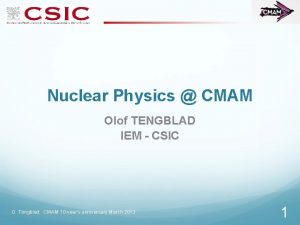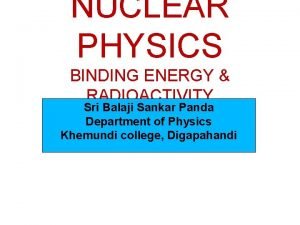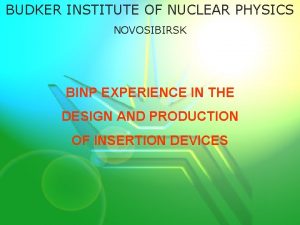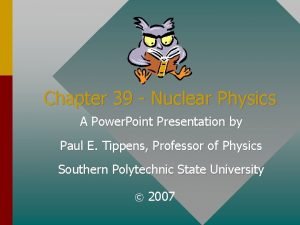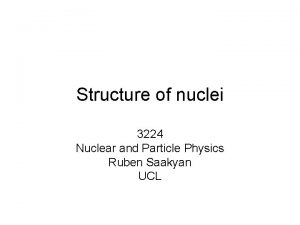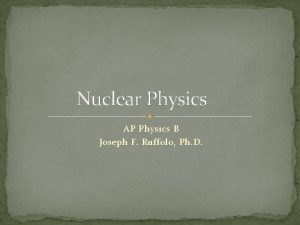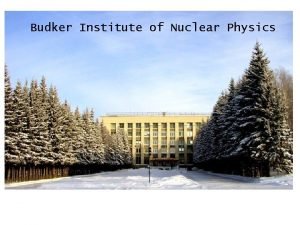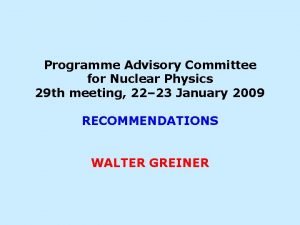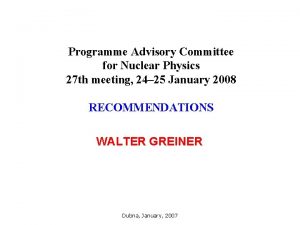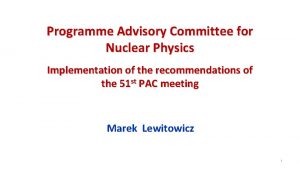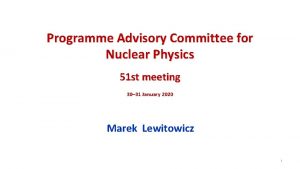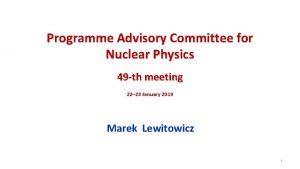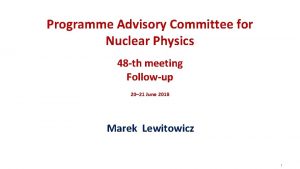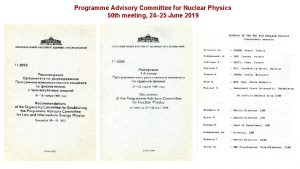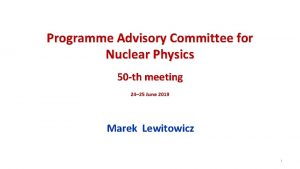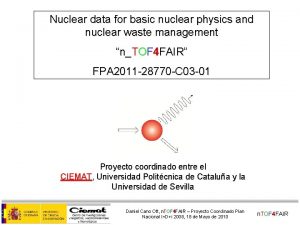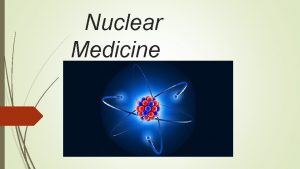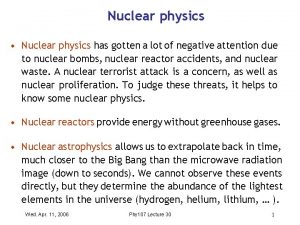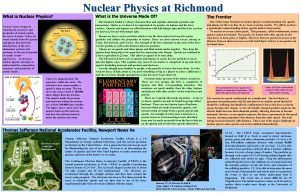Programme Advisory Committee for Nuclear Physics 52 nd

















- Slides: 17

Programme Advisory Committee for Nuclear Physics 52 nd meeting 25 June 2020 Marek Lewitowicz 1

One of the first remote PAC meetings at JINR 2

Programme Advisory Committee for Nuclear Physics, 52 nd meeting, 25 June 2020 1. Opening of the meeting M. Lewitowicz 2. Implementation of the recommendations of the previous PAC meeting M. Lewitowicz 3. Information on the Resolution of the 127 th session of the JINR Scientific Council (February 2020) and on the decisions of the S. Dmitriev JINR Committee of Plenipotentiaries (June 2020) 4. Report on the concluding theme “Improvement of the JINR Phasotron and Design of Cyclotrons G. Karamysheva for Fundamental and Applied Research” Referees: A. Maj, C. Petitjean, , Z. Vilakazi, E. Vardaci 5. Status of preparation of a new project “Modernization of the EG-5 accelerator and development of its A. Doroshkevich experimental infrastructure” Referees: G. Kim, M. Lewitowicz, V. Nesvizhevsky, V. Ostashko 6. Proposal for opening a new project: “Muon ordinary capture for the nuclear matrix elements in 2β-decays D. Zinatulina (project MONUMENT)” Referees: C. Beck, F. Piquemal, C. Petitjean, I. Štekl, 7. Preparation of the PAC recommendations 8. PAC recommendations 9. Closing of the meeting 3

Theme “Improvement of the JINR Phasotron and Design of Cyclotrons for Fundamental and Applied Research” • Improvement of the JINR Phasotron and beam channels. Shakun N. G. , Yakovenko S. L. • Design and modernization of the cyclotrons for medical purposes. Karamysheva G. A. • Research and development of the superconducting cyclotron for proton therapy for IPP CAS (Hefei, China). Shirkov G. D. • Investigation of the high-current beam acceleration in cyclotrons. Vorozhtsov S. B. Galina Karamysheva 4

Theme “Improvement of the JINR Phasotron and Design of Cyclotrons for Fundamental and Applied Research” Galina Karamysheva • Improvement of the JINR Phasotron and beam channels. • Improving of the power supply system of the Phasotron and beam lines was performed. Modern semiconductor converters feeding the magnetic systems instead of the motor generators have been put into operation; • Automatic control system for the transport line has been implemented together with improvement of regulation and stabilizing system by replacing electronic equipment and new software development. • All switching devices were replaced with modern ones in the power supply systems of the beam lines; As a result of the modernization, the electric-power saving amounted to about 900 k. W. In 2016 -2019, Phasotron operated an average of 1000 hours per year. Of these, 80% were spent for medical research, 13% for experiments PHASE, BURAN and 7% of the time for the needs of the accelerator. In 2020, the planned Phasotron operating time is 500 hours. It will be used mostly for radiobiological research. 5

C 235 V 3 cyclotron (IBA, Belgium) • Design and modernization of the cyclotrons for medical purposes. • The hospital center of radiation medicine was founded recently in Dimitrovgrad for clinical application of advanced cancer therapy methods. • The C 235 V 3 cyclotron improved by specialists from the JINR was manufactured by IBA company in Belgium. • The C 235 V 3 cyclotron: • was mounted, • its magnetic field was properly configured, • acceleration conditions were optimized, • beam extraction system tests were carried out in JINR after which the system was supplied to Dimitrovgrad. 6

Theme “Improvement of the JINR Phasotron and Design of Cyclotrons for Fundamental and Applied Research” • Research and development of the superconducting cyclotron for proton therapy for IPP CAS (Hefei, China) Main cyclotron SC 200 characteristics: • • Compact design Fixed energy, fixed field and fixed RF frequency Accelerated particles: protons Bending limit W=200 Me. V Superconducting coils enclosed in a cryostat, all other parts are warm Injection by PIG ion source Extraction with an electrostatic deflector and passive magnetic channels Main results: • Design of the cyclotron was finished. • Accomplished: • adequate model of the magnet, • adequate model of plug dimensions and dee tips geometry in the center. • Accelerating field was simulated. • Beam dynamics simulation shows sufficient quality of the center region and the acceleration zone. • No resonances were observed in the whole accelerating region in beam dynamics simulations. • Efficiency of the beam extraction up to 70 %. • Cyclotron is manufactured. Assembling, shimming and commissioning are under way. 7

Theme “Improvement of the JINR Phasotron and Design of Cyclotrons for Fundamental and Applied Research” • Research and development of the superconducting cyclotron for proton therapy New development: SC-230 superconducting cyclotron Design of cyclotron with: • Low power consumption. • High quality of the beam. • Minimum engineering efforts and challenges. • Reasonable size and weight Ion source Final energy, Me. V Pole radius, mm SC coil, warm yoke PIG 230 1350 Mean magn. field (center), T 1. 5 Dimensions (height×diameter), m 1. 7 × 4 Weight, tonnes RF frequency, MHz Harmonic number Number of RF cavities 130 91. 5 4 4 Voltage, center/extraction k. V 35/90 RF power, k. W 40 Magnet type An accelerator with such parameters can become potentially the cheapest and most energy-efficient accelerator for proton therapy due to low-energy consumption of the accelerating system. The SC 230 accelerator has become a candidate for further realization of the biomedical research programme at JINR. 8

Theme “Improvement of the JINR Phasotron and Design of Cyclotrons for Fundamental and Applied Research” JINR Nuclear Physics PAC statements & recommendations The report presented by the authors was of high technical standard and clearly showcases the depth of JINR’s expertise. However, it is unclear which direction JINR will choose towards the realization of a modern proton therapy facility. Clear criteria need to be formulated according to which the choice of the dedicated medical accelerator can be made. In particular, it would be commendable if more details are presented, for example, on how many patients and fractions for proton therapy are planned. Recommendation. • The PAC took note of the report on the concluding theme “Improvement of the JINR Phasotron and Design of Cyclotrons for Fundamental and Applied Research”. • The PAC recommends continuing the studies planned by the team in the field of development, construction and upgrade of cyclotrons, continuing cooperation in the field of medical cyclotrons within the framework of one of themes of the Dzhelepov Laboratory of Nuclear Problems. • The PAC recommends that the JINR Directorate make soon a decision on this direction and support the realization of an optimized facility for proton therapy with high priority. 9

The preparation of a new project “Modernization of the EG-5 accelerator and development of its experimental infrastructure” • The PAC heard the well prepared and documented report on the plans for the development of the EG-5 accelerator and its experimental infrastructure at FLNP. Alexander Doroshkevich • The authors following the previous NP PAC recommendations compared in detail two technical solutions: a modernization of the existing EG-5 accelerator and a purchase of a new accelerator with similar design parameters. Scientific program 1. Nuclear physics. The study of the 2. Condensed matter physics. properties of excited nuclei, reactions with the emission of charged particles, fission physics, obtaining relevant data for astrophysics, nuclear energy and the problem of transmutation of nuclear waste using neutron- and gamma-induced reactions. Application of neutron physics methods in other fields of science and technology: • Radiation material science; • Radiobiology; • Nuclear medicine; • Solid state Physics. 3. Applied and methodical research 10

Modernization of the EG-5 accelerator and development of its experimental infrastructure Goal Providing technical conditions for the implementation of the scientific program of PTP JINR (Theme: 03 -4 -1128 -2017/2022). Main Tasks Technical task Restoring the technical parameters of the EG-5 accelerator: Energy of over 4, 1 Me. V at the beam current of more 50 mk. A. Ways of realization - Tube replacement; - Modernization of the EG -5 infrastructure; - Young staff training. • Revival the research of reactions with fast quasimonoenergetic neutrons at JINR; • Providing the microbeam project implementation; • Development of methods of elemental analysis of deep profiles due to: • increasing performance of the spectrometer; • developing new methods for elemental analysis of nanopowder and micropowder object; • Training of human resources. 11

Project Costs Stage / Option Cost, k$ 1 Repair of the accelerator tower premises 167 2 Replacement of a high-voltage tube with divider and ion source 318 3 Replacing a compressor in the gas compressor section 64 4 Automation of technological systems of EG-5 105 of EG-5 research 5 Modernization infrastructure: Installation of a spectrometers complex RBS “Endstation RC 43” 6 Installation of a laboratory for the research samples preparation Total: 628 Stage / Option 1 Overhaul / building of the new accelerator premise 700 2 Service equipment purchase: (Recirculation equipment for the accelerator premise; uninterruptible power supply system; chiller for accelerator systems and gas compressor stations; SF 6 gas; general laboratory equipment) 1000 3 Accelerator purchase 4300 4 Modernization of EG-5 research infrastructure: Installation of a spectrometers complex RBS “Endstation RC 43” 218 1500 Cost, k$ 5 Installation of a laboratory for the research samples preparation Estimated project cost: 0, 5 M$ / year (3 years) + detailed SWOT analysis of both solutions Total: Estimated project cost: 2, 290 M$ / year (3 years) 12 628 218 6 846

The preparation of a new project “Modernization of the EG-5 accelerator and development of its experimental infrastructure” JINR Nuclear Physics PAC statements & recommendations The PAC heard the well prepared and documented report on the plans for the development of the EG-5 accelerator and its experimental infrastructure at FLNP. The authors compared in detail two technical solutions: a modernization of the existing EG-5 accelerator and a purchase of a new accelerator with similar design parameters. Recommendation. • The PAC recommends the realization of modernization of the EG-5 accelerator with first priority. • The PAC recommends preparing and opening a project to modernize the existing accelerator and associated experimental infrastructure activities under theme “Investigations of Neutron Nuclear Interactions and Properties of the Neutron” with financing from the budget of the current Seven. Year Plan for the Development of JINR, starting in 2021. 13

New project: “Muon Ordinary capture for the NUclear Matrix elem. ENTs in 2β-decays (project MONUMENT)” Daniya Zinatulina • The PAC heard the proposal to open a new project “Measurement of ordinary muon capture for testing nuclear matrix elements of 2βdecays (project MONUMENT)”. • This project is aimed at carrying out measurements of muon capture at several daughter candidates on 2β-decay nuclei. πE 1 14

New project: “Muon Ordinary capture for the NUclear Matrix elem. ENTs in 2β-decays (project MONUMENT)” Objectives and estimated results It is proposed to carry out a research program which includes three beam time periods at the πE 1 -2 beam line of PSI over three years to pursue the following scientific objectives: • Measurement of the total muon capture rates in the isotopically enriched isotopes 96 Mo, 100 Mo, 40 Ca, 56 Fe and 32 S. The measurements are related to the Nuclear Matrix Elements calculations for the Double Beta Decay of 96 Zr. • Extraction of the partial muon capture rates to the bound states in 76 As, 96 Nb, 100 Nb, 40 K, 56 Mn and 32 P following Ordinary Muon Capture (OMC) in 76 Se, 96 Mo, 100 Mo, 40 Ca, 56 Fe and 32 S, respectively. Comparison with the calculated nuclear matrix elements which will be carried out by theory groups (not funded through this proposal). • The radioactive production rates will be compared with the proton and neutron emission model to derive the muoncapture strength function and the associated giant resonance (GR) peak. These results will be compared with recent theoretical results. • The muonic X-rays spectra measured in OMC will be implemented to the already existing Mesoroentgen electronic catalogue (muxrays. jinr. ru). 15

Recommendation. • The measurements of muon capture will be carried out at the meson factory of the Paul Scherrer Institute (PSI) in Switzerland. This application was reviewed and approved by the PSI User committee; the beam time was officially granted in 2020 for a preliminary study of 136 Ba with a further experimental programme for at least three years. • The participants of the MONUMENT project have required expertise and experience in the field of high-precision nuclear spectroscopy and its implementation for studying not only rare processes but also muon capture. • The PAC recommends opening the project MONUMENT for 2021– 2023 with first priority and providing the project with full requested funding. 16

THANK YOU FOR YOUR ATTENTION! 17
 Aviation rulemaking advisory committee
Aviation rulemaking advisory committee Learning without burden images
Learning without burden images Trade union advisory committee
Trade union advisory committee Robert kerzner
Robert kerzner Working with models
Working with models Lesson 15 nuclear quest nuclear reactions
Lesson 15 nuclear quest nuclear reactions Fisión nuclear vs fision nuclear
Fisión nuclear vs fision nuclear Nuclear industry assessment committee
Nuclear industry assessment committee Nuclear physics
Nuclear physics Nuclear physics
Nuclear physics Quantum and nuclear physics
Quantum and nuclear physics Nuclear physics
Nuclear physics Scattering cross section in nuclear physics
Scattering cross section in nuclear physics Budker institute of nuclear physics
Budker institute of nuclear physics Nuclear physics topics for presentation
Nuclear physics topics for presentation Magic number in nuclear physics
Magic number in nuclear physics Nuclear physics b
Nuclear physics b Budker institute of nuclear physics
Budker institute of nuclear physics







